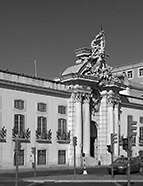

Thus, the reordering of what had been possible to save and the formation of the new archive began in 1756, the date on which the current documentary collection at the Military History Archive began. The Charter of 12 June 1822 established the separation of the two Secretariats of State, which were housed in the Palácio da Regência in Rossio, however, due to the inadequacy of these facilities, the archive of both Secretariats remained in the Pátio das Vacas. Nevertheless, it was immediately divided into two separate archives - the diplomatic and the military - which led to some degree of chaos due to the invalidation of the existing inventory. After the conflict of the Liberal struggles in 1834, it was determined that the Ajuda archive should incorporate the "modern archive" of the War Secretariat, corresponding to the period from 1820 to 1833, the "archive of the Liberal War Secretariat" relating to the time of the Siege of Porto (1832-33), the "archive of Terceira" from the period of the Constitutional Government of the Azores, the archives of the extinct General Inspectorates of Infantry and Cavalry, both created in the 18th century, and finally, the archive of the extinct War Council, as will be seen.
In 1845, the archive housed in the Palacete do Pátio das Vacas was hurriedly and disorderdly transferred to the lower floor of the Ajuda Palace and in 1862, to the Botanical Garden building. After the Oficina ou Fábrica de Refinação do Salitre [Refining Office or Factory of Saltpetre] was closed in Alcântara, in July 1877 the Ministry of War decided to use most of the building as the headquarters of the General Archive, immediately determining that the removal should begin with the Archive in the Botanical Garden (the history archive), followed in 1878 by part of the Archive in Terreiro do Paço (the other main part, that was immediately necessary for the service of the War Secretariat, was transferred to the Navy Arsenal building). The incorporation of the administrative archive of the War Secretariat (1833 to 1877) into the important Ajuda Archive (1640 to 1833) occurred in 1878, with no criteria, leading to constant disorder thereafter. With the establishment of the Lisbon to Torres Vedras railway line, the Archive building was sold to the railway company. Due to the urgency of building the Alcântara station, the archive was transferred to the south wing of the former Palácio dos Condes de Resende, in Campo de Santa Clara, beginning on 28 November 1884, with a 10 day deadline.
